This is Part 2 of a 3 part series of articles written by Charles Morgan and Hubert Walker for CoinWeek.com, an on-line media source for print and video rare coin and currency news, reprinted at the Museum Of UnCut Funk with the permission of Mr. Morgan and Mr. Walker.
Twenty-eight years passed between the last Carver Washington half dollar and the George Washington 250th Birthday half dollar. The purpose, scope, and distribution of commemorative coins under the resurrected program bore no resemblance to that which came before. There were still those, like Armand Hammer, who sought to profit from of bloated commemorative series of their own design[1], but for the most part the deeply corrupt practice of the government minting collectible coins for the benefit of one individual or organization had come to an end.
During this twenty-eight year gap, America bore witness to tremendous social change.
In 1954, the Supreme Court decided in Hernandez v. Texas that the 14th Amendment of the Constitution gave equal protection to Mexican-American citizens as well as citizens from all other racial groups. Two weeks later, the court struck down the fifty-eight year old ruling in Plessy v. Ferguson, siding against the Topeka, Kansas Board of Education that sought to maintain segregated schools.
Of course, the decision in Brown did not instantly bring fairness and equality to the nation’s public schools, especially those in the south. At first, many states sought to stall integration. They employed bullying tactics, sometimes stooping to mob violence and even murder. Politicians, ever quick to seize political advantage from the sentiment of the day, mounted campaigns to defy federal law. In some states, such as Booker T. Washington’s birth state of Virginia, a campaign of massive resistance was undertaken and many public school systems were shut down.
America was tearing itself to pieces over a social system that had deep cultural roots but no legitimacy in a Constitutionally-governed society. These growing pains continued for more than a decade of Grand Guignol violence, political assassinations and war in Việt Nam.
By the time the next African-American appeared on a U.S. coin, most of the tensions of the forties, fifties, and sixties were in the past. Pockets of antagonism still existed, prejudice and inadequate social infrastructure was still with us, but culturally America was ready to at least acknowledge black figures and entertainers, sit beside black men and women on buses and trains, attend public schools and universities with black children, and even fight and die alongside black service members.
In part two of our three part series on African-American coins, Hubert and I discuss African-American representation on modern commemorative coinage.
JACKIE ROBINSON’S LEGACY OF COURAGE GOES FAR BEYOND THE BASEBALL DIAMOND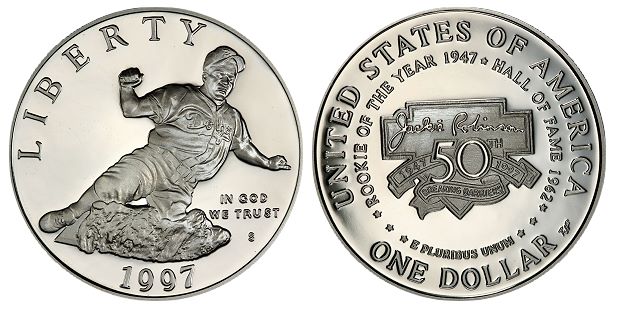
The Jackie Robinson Commemorative dollar remains popular; the gold $5 coin (not pictured) is one of the key coins from the modern gold commemorative series.
A Civil Rights Pioneer
Even before Jackie Robinson made baseball history, he was a fearless advocate for justice and equality. Knowing that the Army had adopted a desegregationist policy, Robinson refused to give up his seat on an Army chartered bus when the driver, seeing him sitting next to a woman he thought was white (she wasn’t), ordered Robinson to move.
Jules Tygiel, author of Baseball’s Greatest Experiment: Jackie Robinson and His Legacy, wrote that Robinson faced an all-out assault of humiliations coming from senior officers and even a female civilian stenographer who would pepper the Army’s interrogation with questions like: “Don’t you know you have no right sitting up there in the white part of the bus?”[1]Because of the incident, and Robinson’s unwillingness to yield, he was charged with a number of offenses, including insubordination and an absurd charge of public drunkenness.
Most of the counts were dropped by the time Robinson went to trial, and he was acquitted of the only two charges he faced. Three months later he separated from the Army. Once released, Robinson tried out for the Kansas City Monarchs, one of the top teams in the Negro American League. In his only season with the team, Robinson hit over .400.
Crossing the Color Line
Jackie Robinson broke baseball’s color barrier in 1945 when he was signed by Brooklyn Dodgers’ General Manager Branch Rickey to a minor league contract on August 28. The following season Robinson and Johnny Wright, a willowy twenty-six year old standout from the Negro Leagues, started with the Dodgers’ AAA team in Montreal. Wright, a year younger than Robinson and considered by some the better prospect[1], never lived up to his potential and was let go at the end of the season. Robinson, however, went on to be the first African-American player in Major League Baseball since Moses Fleetwood Walker and his brother Weldy played for the Toledo Blue Stockings in 1884 – before the institution of the “color-line”.[2]
Robinson was brilliant on the field throughout his ten year major league career, but he endured a relentless torrent of abuse at the beginning. He was accused of being too proud, too bullheaded. Dodger Owner Martin O’Malley is said to have called him “Rickey’s prima donna”.[3] At the end of the 1956 season, the Brooklyn Dodgers traded Robinson to the New York Giants for the equivalent of a sack of baseballs, a well-traveled yet not particularly effective left handed relief pitcher named Dick Littlefield, who had a peculiar knack for being traded mid-season (twice in 1956). Robinson, however, was done with baseball. He never reported to the Giants, hung up his cleats, and took a job as the Vice President of New York-based coffee company, Chock full o’Nuts.
Despite being celebrated in the black community as a ballplayer and cultural icon, Robinson was investigated by the FBI and compelled to testify in front of the House Un-American Activities Committee against actor and social activist Paul Robeson (who would find himself blacklisted due to his criticism of the American government).[4] He was the victim of an extortion attempt in 1953[5], and again investigated by the FBI for participating along with Martin Luther King, Jr. in James Meredith’s March Against Fear.[6]
Robinson’s Image Reborn
By 1997, Jackie Robinson’s legacy as a baseball player and a civil rights pioneer were beyond reproach. His successes on and off the diamond were celebrated. The Rookie of the Year award was renamed the Jackie Robinson Award in 1987 to coincide with the 40th anniversary of his inaugural season. In 1997, Major League Baseball retired Robinson’s jersey number “42”, grandfathering then-active players who wore it. To this date, only Yankees pitcher Mariano Rivera wears the number 42 and Rivera’s career accomplishments mean that the “42” jersey would have undoubtedly been retired by the New York Yankees even without the commissioner’s edict.
The Coins
To tie-in with Major League Baseball’s celebration, Congress authorized the issuing of two Jackie Robinson coins. The coins were part of an “omnibus coin bill” that also included authorizations for a coin commemorating the 150th anniversary of the death of Dolley Madison, $5 gold coins honoring George Washington and Franklin Delano Roosevelt, a dollar honoring the 125th anniversary of the establishment of Yellowstone National Park, as well as a dollar commemorating the 275th anniversary of the birth of Crispus Attucks (more on this coin in a bit), as well as authorization for a study of a fifty state commemorative coin program, which became the State Quarters series of 1999-2008.[7]
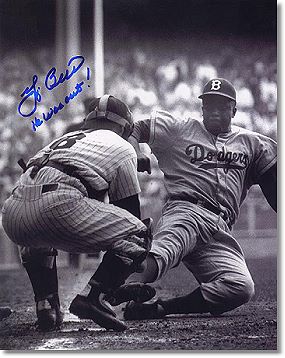
The commemorative $5 gold and silver dollars honoring Robinson celebrate his impact on baseball.
The obverse of the dollar shows Robinson’s daring steal of home in game one of the 1955 World Series against the New York Yankees. This is one of the defining moments of the Hall of Famer’s career, though not without controversy: Yankees catcher Yogi Berramaintains to this day that Robinson was out!
The reverse features Major League Baseball’s “Jackie Robinson: Breaking Barriers 50th Anniversary” logo accompanied with inscriptions honoring his 1947 Rookie of the Year Award and 1962 induction into the Baseball Hall of Fame. Credit for the design went to William C. Cousins and James Peed. Business strikes are scarcer than proofs, but both versions are popular with collectors. Significant premiums go for coins certified MS-70.
The Jackie Robinson $5 gold coin focuses on the totality of Robinson’s achievements as an American. The obverse features a portrait of an older Robinson while the reverse features a baseball with the inscription “1919-1972 Legacy of Courage”. The coin was also designed by William C. Cousins and James Peed. Initially offered at $180, the gold business strike version sold incredibly poorly, moving only 5,174 pieces. Proofs sold better, moving 24,072 pieces. Because of the low mintage (read: immense buyer apathy) of the uncirculated version, the Jackie Robinson $5 became the key issue from the modern gold commemorative series and quickly commanded a significant premium. The chart below shows recent price performance for both versions.
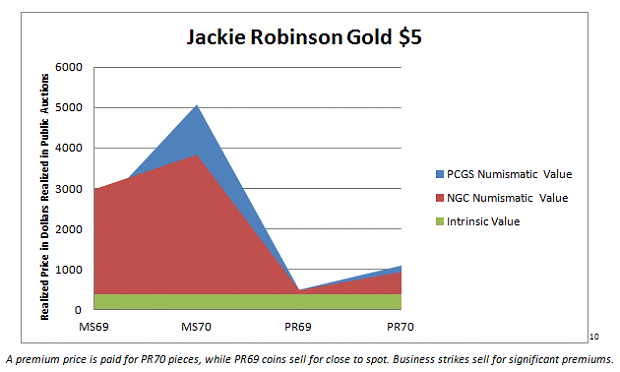
A MAN JOHN ADAMS DIDN’T THINK MUCH OF…
Crispus Attucks, “Black Revolutionary War Patriot”
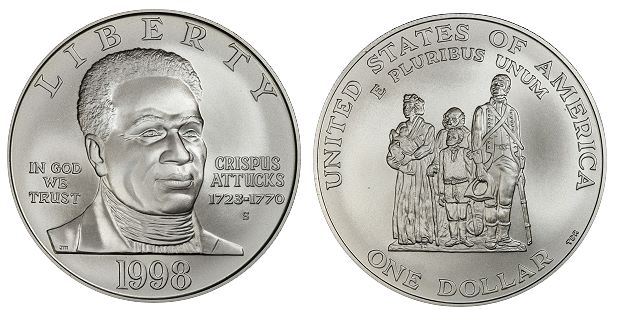
John Adams got Attucks’ killers acquitted in a famous pre-Revolutionary War trial. He was one of five men assembled in Boston killed by the undisciplined fire of British troops
Not much is agreed about concerning Crispus Attucks, who is believed by some to have been a mixed race (African and native Wampanoag) merchant seaman residing in Boston. In 1770, he was at the front line of a scrum with British troops that resulted in the shooting death of Attucks, along with four other men. Six additional colonists were wounded.
At trial, Boston lawyer and future President of the United States John Adams defended the British troops, calling Attucks and his companions that evening a “motley rabble of saucy boys, negros and molattoes [sic], Irish Teagues and outlandish jack tars”.[1]
Adams got the soldiers acquitted, but the incident proved a catalyst for the propaganda war leading up to the American Revolution. Two years after the incident, Samuel Adams dubbed the event “The Boston Massacre”.
In 1998, to commemorate Attucks’ role as a “Revolutionary War Black Patriot”, a commemorative dollar bearing his supposed likeness was issued.
A Memorial Stalled…
Ostensibly, proceeds from the sale of the Attucks dollar were earmarked to go to the Secretary of the “Black Revolutionary War Patriots Foundation for the purpose of establishing an endowment to support the construction of a Black Revolutionary War Patriots Memorial” in Washington, DC.[2]
In an article published in the Washington Post, staff writer Petula Dvorak described the would-be monument as an “arcing granite wall across from a similarly long and curving bronze statue built into the crook of a pathway through Constitution Gardens”.[3] The plans were drawn up by Ed Dwight, the artist also responsible for the Attucks commemorative dollar reverse.
Unfortunately for the memorial organizers, the National Park Service placed a moratorium on the construction of new monuments on the Mall in 2003 and the foundation’s authorization to use their proposed site expired in 2005. The effort to raise capital was not much boosted by the sale of the commemorative dollars. Though the coin wasn’t a spectacular failure (its combined 112,280 coins sold being typical for the period), the Foundation wasn’t able to raise enough funds to begin construction.
With the planned construction a bust, a new group headed by Maurice Barboza set out to resuscitate the plan, testifying before Congress on September 16, 2010 about the importance of the contributions of African-Americans during the Revolutionary War and his plans to “instruct the landscape of Washington in the unifying narrative of African-American patriots and freedom seekers of the Revolutionary War”[4]
To date the memorial has not been built.
THE LITTLE ROCK NINE
Brave beyond their years…
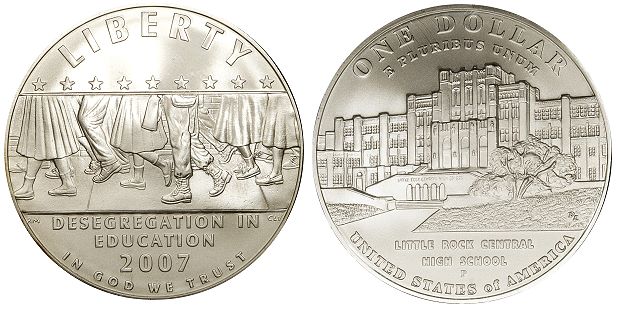
The Problem We All Lived With
A color line of a different sort was crossed by nine brave children in Little Rock, Arkansas in September, 1957. The Little Rock Nine, as they became known, were normal American children with only one skin-deep feature standing between them and living a life of dignity.
Amazingly, Little Rock was a fairly progressive southern city in terms of race relations going into the 1957-1958 school year, having already desegregated their public libraries and bus system. But the idea of opening up all-white schools to African-American children struck a nerve with many of the city’s residents, who then mobilized to stop integration through physical threats, verbal abuse, and political pressure against the federal mandate.
Many saw no problem operating separate schools in order to maintain the status quo. But those who argued that African-American children were benefiting from separate-but-equal schooling ignored the myopic graduation rates at all-black schools, the poor condition of the facilities, and the generations-old books passed down to the black schools once the white schools moved on to newer ones (many of these hand-me-down books had racial epithets written in the margins)[5]. The humiliation and oppression was palpable in obvious and not-so-obvious ways[6].
Unfortunately, the story didn’t end there. The 1958-1959 school year became known as “The Lost Year” after Governor Orval Faubus called a special session of the Arkansas General Assembly to pass a bill called Act 4, which gave municipalities the authority to shut down schools threatened with integration. Another bill provided students displaced by school closures with funding to attend the school of their choice. Compare this bit of legislation to current “school choice” initiatives, there are similarities.
Further federal court intervention took the power out of the governor’s and the state’s hands. By order of the court, the closed schools in Little Rock reopened, a nationwide program of busing integrated all public schools. Gradually the state of emergency shifted from the repercussions of forced integration to public arguments over the utility of public education, the funding of it, and the nature of what’s being taught.
The Little Rock Nine: Then and Now
Ernest Green was an Eagle Scout and an active churchgoer. He was the first African-American to graduate from Little Rock Central High School. Martin Luther King, Jr. attended his graduation. Green served as Assistant Labor Secretary in the Carter Administration and later worked for Lehman Brothers.
Minnijean Brown was suspended and later expelled for reacting to taunts from white students. She was an American expatriate living in Canada for a number of years and later served as the Deputy Assistant Director of the Interior in the Clinton Administration.
Carlotta Walls LaNier’s father was a veteran of World War II. Carlotta had to take correspondence courses in 1958-1959 when Little Rock high schools were closed. She returned the following year and graduated. She later attended Colorado State College and is now a real estate broker and author.
A white student tried to blind Melba Beals by throwing acid into her eyes. She moved to Santa Rosa after the school was shut down in 1958-1959. Beals earned a Master’s degree in Journalism from Columbia University and teaches Journalism at Domincan University of California.
Elizabeth Eckford’s humiliation and abuse was forever memorialized in a snapshot from Will Counts. Counts, a photographer for UPI, caught Eckford in the eye of the storm, being jeered at and taunted by white schoolmates and townsfolk. Just behind her was a screaming white teenage girl named Hazel Massery. Massery tried to make amends with Eckford years later, and for a time the two were friends.[7]But those who’ve known her over the years say that the experience really affected her, and that she doesn’t much like discussing that period as it brings back a flood of painful memories.
Despite having a heart condition, Thelma Mothershed braved torment and attended Little Rock Central High School as a junior in 1957-1958. During that school year her parents sent President Eisenhower a letter thanking him for sending the 101st Airborne Division to protect their daughter. He wrote back thanking them for having the courage to send their daughter to the all-white school.[8] She completed her senior year through correspondence courses and received her diploma from Central High School by mail. She earned a Master’s degree from Southern Illinois University and taught Home Economics in the East St. Louis School System for nearly 30 years.
Gloria Ray Karlmark remembered counting each day to make sure that the nine African-American kids that went to school that day were all accounted for before they left to go home. She was fifteen years old in 1957. Later, Karlmark went on to earn a Bachelor’s degree in Chemistry and Mathematics. She now resides in the Netherlands.
Terrence Roberts was also fifteen when he attended Little Rock Central High School. When the school was shut down the following year he was forced to complete his studies in Los Angeles. Roberts earned a Ph.D. in Psychology from Southern Illinois University and taught at Antioch University in Los Angeles.
Jefferson Thomas entered Little Rock Central High as a sophomore. He graduated from the school in 1960 and went on to serve as an Army infantryman during the war in Việt Nam. He earned a Bachelor’s degree from Los Angeles State College and spent the majority of his career working as an accounting clerk with the Department of Defense. Thomas died of pancreatic cancer in 2010.[9]
A Most Political Piece
The coin’s obverse features a letterboxed vignette of nine teenage school children being escorted by a member of the 101st Airborne, sent to Little Rock by President Eisenhower to serve in a protection detail. The image recalls Norman Rockwell’s famous illustration “The Problem We All Live With”. Above this image are nine stars, each representing a member of the Little Rock Nine.
The coin is also notable for depicting living persons, technically illegal after an 1866 Act of Congress. The Little Rock Nine joined Governor Thomas Kilby (1921 Alabama Centennial half dollar), Calvin Coolidge (1925 Sesquicentennial of American Independence half dollar), Carter Glass (1936 Lynchburg Sesquicentennial half dollar), and Senator Joseph Robinson (1936 Robinson-Arkansas half dollar). Also interesting is the design choice to depict only legs and feet.
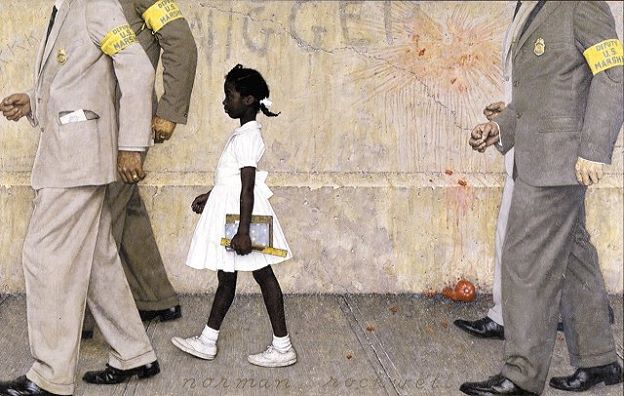
Ruby Ridges (age 6) being escorted to school by the U.S. Marshalls as depicted by Norman Rockwell (Originally published in Look Magazine).
Beneath is the inscription DESEGREGATION IN EDUCATION. The reverse shows the beautifully detailed rendering of the Little Rock Central High School. The obverse was designed by Richard Masters and Charles Vickers. The reverse was designed by Don Everhart.
As U.S. Commemoratives go, The Little Rock Central High School Desegregation dollar is probably the most politically sensitive coin ever released. While the classic and modern commemorative series each had their fair share of controversial figures playing some role behind the scenes, the coins themselves had always been innocuous and non-assuming. Celebrating desegregation on a coin in some ways serves as the federal government’s mea culpa for its poor record of demanding and insuring liberty for all.
The coin sold fairly well, with 124,678 business strikes minted and 66,093 proofs (an unusual reversal as most modern commemoratives see a much higher demand for proofs than business strikes)[1].
African-Americans have also appeared on other commemorative coins, more or less as athletic archetypes, or in the case of the Jamestown 400th Anniversary dollar (2007) as an unnamed slave woman. We find that the coins that we’ve discussed above are the most significant of the modern commemorative series up to now.
The story of African-American coinage continues next week with Part 3: Hidden in Plain Sight & Designs Considered.
FLIP OF A COIN:
Continuing the Theme: At the end of June, the Congressional Gold Medal was awarded to the Montford Point Marines. From 1942 until 1949, when President Harry S. Truman ended segregation in the armed forces with Executive Order #9981, black marines trained at Montford Point, a segregated installation located at Camp Lejeune, North Carolina. The Mint is selling reproductions of the medal made of bronze.
From the Walker/ Morgan Numismatic Files: Colonel E. H. R. Green, titan of the railroad industry, was a collector of some note and notoriety. Not only did he once own all five 1913 Liberty “V” nickels at the same time, but he also owned the full 100 stamp sheet of “inverted Jenny” stamps. He also assembled a famous collection of pornographic films. Many thanks to Pete Smith and his excellent e-book American Numismatic Biographies (2010). You can download it for free here.
For those planning to attend the 2012 World’s Fair of Money℠, be sure to check out one of an estimated 275 surviving specimens of the 1792 Half Disme. The coin is on display for the first time after being donated to the Money Museum last December by Steven L. Contursi.
Charles Morgan is a member of the Ike Group and is working with Rob Ezerman on GradeView™: Eisenhower Dollars and with longtime collaborator Hubert Walker on a number of other projects, including the Registry Set Collector’s Guide to US Coinage, which will be published sometime next year.
Hubert Walker’s background is in the classics. A nationally-recognized Latin scholar when younger, Hubert’s interest in history and symbology connects him to modern coins as well as ancients. He also likes the movies, among other things.
Charles and Hubert’s informative columns appear weekly at CoinWeek.com.
[1] Bowers, Q. David “Commemorative Coins of the United States: A Complete Encyclopedia”
[2] Tygiel, Jules. “The Court-Martial of Jackie Robinson.” American Heritage Magazine. August/ September 1984.
[3] http://files.usgwarchives.net/la/orleans/newspapers/00000344.txt
[4] Kirsch, George B., Othello Harris, and Claire Elaine Nolte, eds. (2000). “The Right to Travel”. Encyclopedia of Ethnicity and Sports in the United States. Westport, CT: Greenwood
[5] Stout, Glenn; Richard A. Johnson .The Dodgers: 120 Years of Dodgers Baseball. Boston: Houghton Mifflin Harcourt. 2004.
[6] Duberman, Martin. “The Right to Travel”. Paul Robeson. New York: Knopf. 1989. Print.
[7] http://vault.fbi.gov/Jack%20Roosevelt%20%28Jackie%29%20Robinson/Jack%20Roosevelt%20%28Jackie%29%20Robinson%20Part%201%20of%205/view
[8] Ibid.
[9] http://www.gpo.gov/fdsys/pkg/PLAW-104publ329/pdf/PLAW-104publ329.pdf
[10] Prices based on past five public auction hammer prices for NGC and PCGS graded coins in the listed grades posted at www.pcgs.com. Data pulled 7/4/2012. Intrinsic value based on spot price of $1610/oz.
[11] Flemming, J. “The Trial of William Wemms, James Hartegan, William McCauley, High White, Matthew Killroy, William Warren, John Carrol, and High Montgomery, for the Murder of Crispus Attucks, Samuel Gray, Samuel Maverick, James Caldwell, and Patrick Carr” Self Published. 1770.
[12] Public Law 104-329- October 20, 1996.
[13] Dvorak, Petula. “Memorial for Black Colonial Patriots Is in Limbo”. Washington Post. 28 October, 2005.
[14] http://naturalresources.house.gov/UploadedFiles/BarbozaTestimony09.16.10.pdf
[15] WCVE Richmond PBS. Locked Out: The Fall of Massive Resistance. WCVE Richmond PBS. 2009. Video.
[16] Kelleher, Elizabeth. “After Facing Mobs 50 Years Ago, Nine Go Home to Honors: Little Rock Nine became part of civil rights history as teens”. Bureau of International Information Programs, US Department of State. 20 August, 2007.
[17] Margolick, David. “Through a Lens, Darkly” Vanity Fair. 24 September, 2007.
[18] http://www.america.gov/st/washfile-english/2007/August/20070823150405berehellek0.5942652.html
[19] “Civil-rights figure Jefferson Thomas remembered as hero” The Columbus Dispatch. 12 September, 2010.
[20] http://www.nrm.org/2010/10/norman-rockwell%E2%80%99s-%E2%80%9Cthe-problem-we-all-live-with%E2%80%9D-continues-to-resonate-as-important-symbol-for-civil-rights/
[21] Illustration for Look, January 14, 1964. Norman Rockwell Museum Collection.
(c) 2012 Charles Morgan and Hubert Walker and This article originally appeared at www.coinweek.com.

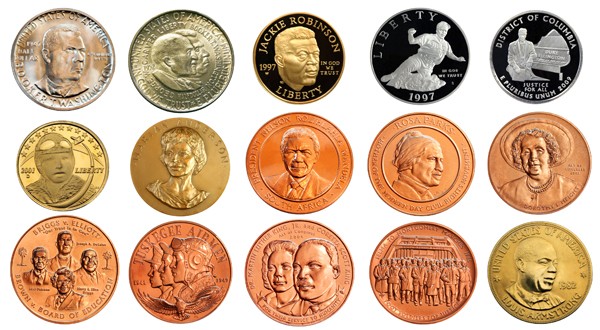


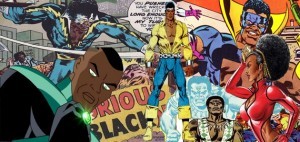

0 Comments